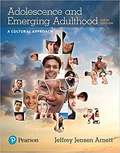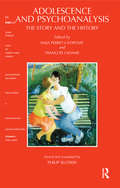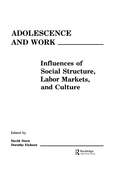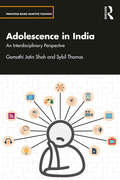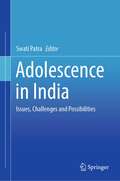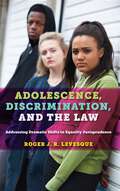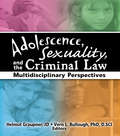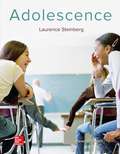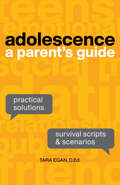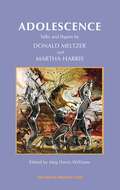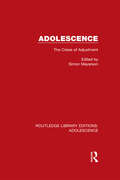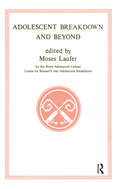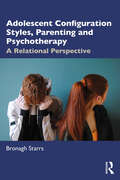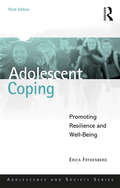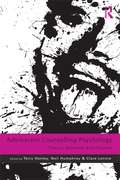- Table View
- List View
Adolescence and Emerging Adulthood: A Cultural Approach
by Jeffrey Jensen ArnettHelps students understand how culture impacts development in adolescence and emerging adulthood. Grounded in a global cultural perspective (within and outside of the US), this text enriches the discussion with historical context and an interdisciplinary approach, including studies from fields such as anthropology and sociology, in addition to the compelling psychological research on adolescent development. This book also takes into account the period of "emerging adulthood" (ages 18-25), a term coined by the author, and an area of study for which Arnett is a leading expert. Arnett continues the fifth edition with new and updated studies, both U. S. and international.
Adolescence and Emerging Adulthood: A Cultural Approach
by Jeffrey Jensen ArnettHelps students understand how culture impacts development in adolescence and emerging adulthood. <p><p> Grounded in a global cultural perspective (within and outside of the US), this text enriches the discussion with historical context and an interdisciplinary approach, including studies from fields such as anthropology and sociology, in addition to the compelling psychological research on adolescent development. This book also takes into account the period of “emerging adulthood” (ages 18-25), a term coined by the author, and an area of study for which Arnett is a leading expert. <p><p> Arnett continues the fifth edition with new and updated studies, both U.S. and international. With Pearson's MyDevelopmentLab Video Series and Powerpoints embedded with video, students can experience a true cross-cultural experience.
Adolescence and Psychoanalysis: The Story and the History
by Philip Slotkin Maja Perret-Catipovic François LadameThis book deals with specific aspects of psychic functioning and development in adolescence. It offers a conspectus of present-day psychoanalytic understanding of the process of adolescence and its vicissitudes. The book is helpful for those interested in the field of adolescent psychoanalysis.
Adolescence and Work: Influences of Social Structure, Labor Markets, and Culture
by David Stern Dorothy EichornThis volume illustrates connections between the concerns of vocational psychology and the adjoining disciplines of sociology, cultural anthropology, and labor economics. The intent is to suggest how vocational psychology and career counseling might recognize more explicitly the ever-changing social influences and institutional constraints that affect individual as they begin,or contemplate beginning, their adult work.
Adolescence in Context
by Tara L. KutherAdolescence in Context by award-winning author Tara L. Kuther is a topically oriented text that connects learners to the science shaping our understanding of today’s teenagers and young adults. Organized around three core themes—the centrality of context, the importance of research, and the applied value of developmental science—the text presents classic and current research, along with foundational theories, framed in real-life intersectional contexts such as sex, gender, race, ethnicity, ability, and socioeconomic status. With the new Second Edition, students can expect to gain a deeper understanding of adolescence that they can apply to their personal lives and future careers.
Adolescence in Context
by Tara L. KutherAdolescence in Context by award-winning author Tara L. Kuther is a topically oriented text that connects learners to the science shaping our understanding of today’s teenagers and young adults. Organized around three core themes—the centrality of context, the importance of research, and the applied value of developmental science—the text presents classic and current research, along with foundational theories, framed in real-life intersectional contexts such as sex, gender, race, ethnicity, ability, and socioeconomic status. With the new Second Edition, students can expect to gain a deeper understanding of adolescence that they can apply to their personal lives and future careers.
Adolescence in Context: Lives in Context
by Dr. Tara L. KutherAdolescence: Lives in Context is a topically oriented text for the Adolescence and Emerging Adulthood development course organized around three key themes: the centrality of context, the importance of research, and the applied value of developmental science. The text, developed by teacher and scholar Tara Kuther, will be written to engage students through her digestible, student-friendly writing style. Adolescence: Lives in Context will deliver current and classic research, foundational theories and will help students to comprehend how those theories apply to their future careers and own lives through a lens of contexts across each developmental stage and topic. ?
Adolescence in Context: Lives in Context
by Dr. Tara L. KutherAdolescence: Lives in Context is a topically oriented text for the Adolescence and Emerging Adulthood development course organized around three key themes: the centrality of context, the importance of research, and the applied value of developmental science. The text, developed by teacher and scholar Tara Kuther, will be written to engage students through her digestible, student-friendly writing style. Adolescence: Lives in Context will deliver current and classic research, foundational theories and will help students to comprehend how those theories apply to their future careers and own lives through a lens of contexts across each developmental stage and topic. ?
Adolescence in India: An Interdisciplinary Perspective (Principles-based Adaptive Teaching)
by Gomathi Jatin Shah Sybil ThomasAdolescence in India: An Interdisciplinary Perspective highlights the need and importance of studying adolescence in the domain of education. Using an interdisciplinary approach, it discusses adolescence from the perspective of sociology, psychology, education and health studies. Against the backdrop of economic development and globalization, the book looks at adolescence in the changing social milieu. It offers an understanding of adolescence by exploring the socio-cultural influences on adolescents and their interactions in various spaces like the school, among peers, family and the media. The book reflects on classroom group processes and instructional practices for better psychosocial growth of adolescents as well as discusses the need for a greater emphasis on making resources available for adolescents to realise and strengthen their skills and agency. The book outlines various life-skills policies and programmes in India and uses vignettes, anecdotes, emerging classroom discussions, case studies, activities, and self-assessment tools and questionnaires to facilitate a deeper understanding of the concept. The book will be of interest to students, teachers, and educators in teaching programmes including educational psychology, adolescent psychology, and human development. It will also be useful for policymakers, NGOs, and public and private sector bodies who work in the field of adolescent psychology.
Adolescence in India: Issues, Challenges and Possibilities
by Swati PatraThis book provides a comprehensive, in-depth and practical approach towards an understanding of the multitude challenges of adolescence in India. Going beyond the traditional ‘storm, stress and strain’ view of adolescents, it focuses on the strengths of adolescents and highlights a community approach towards an understanding of adolescents. The book is divided into three sections. Section 1 introduces the concept of adolescence in the Indian context, discusses the identity development and peer relations in adolescents. Section 2 deliberates on issues and challenges such as depression, suicide, violence, substance use and behavioural addiction, keeping in mind the Indian socio-cultural context. It also highlights concerns of adolescents related to disabilities. Section 3 provides various prevention and intervention measures including both individual-based and group-based interventions to deal with these challenges, thereby facilitating the journey of adolescents. It helps the reader to focus on the positive development of the adolescents. The book is useful for students in psychology, education, counselling, mental health and development. It is also a great resource book for professionals working in the field of health in general and mental health in particular.
Adolescence, Affect and Health (Psychology Library Editions: Emotion)
by Donna Spruijt-MetzOriginally published in 1999, this title covers the entire empirical cycle in adolescent health research and education. It describes in depth the development and evaluation of a health education programme designed to enhance everyday health-related behaviours in an adolescent population, and offers comprehensive reviews of developmental theories of adolescence, ethical and theoretical issues in adolescent health education, and the major theories used in adolescent health research. The research presented here led to the development and testing of a new theory – the Theory of Salient Meanings of Behaviour – which departed from the cognitive theories that had thus far dominated adolescent health education and research, but which had often proved inadequate in describing and predicting adolescent health-related behaviour. The inception, growth, testing, and field testing of this new theory are traced here. The book is designed to appeal to both theoretical and applied scientists in the field of adolescent development, adolescent health and health education. A clear research methodology is set out for the complementary use of a wide range of qualitative and quantitative research methods.
Adolescence, Discrimination, and the Law: Addressing Dramatic Shifts in Equality Jurisprudence
by Roger J.R. LevesqueExplores the shifts and the research used to support civil rights claims of discrimination, particularly relating to minority youths’ rights to equal treatment In the wake of the civil rights movement, the legal system dramatically changed its response to discrimination based on race, gender, and other characteristics. It is now showing signs of yet another dramatic shift, as it moves from considering difference to focusing on neutrality. Rather than seeking to counter subjugation through special protections for groups that have been historically (and currently) disadvantaged, the Court now adopts a “colorblind” approach. Equality now means treating everyone the same way. This book explores these shifts and the research used to support civil rights claims, particularly relating to minority youths’ rights to equal treatment. It integrates developmental theory with work on legal equality and discrimination, showing both how the legal system can benefit from new research on development and how the legal system itself can work to address invidious discrimination given its significant influence on adolescents—especially those who are racial minorities—at a key stage in their developmental life. Adolescents, Discrimination, and the Law articulates the need to address discrimination by recognizing and enlisting the law’s inculcative powers in multiple sites subject to legal regulation, ranging from families, schools, health and justice systems to religious and community groups. The legal system may champion ideals of neutrality in the goals it sets itself for treating individuals, but it cannot remain neutral in the values it supports and imparts. This volume shows that despite the shift to a focus on neutrality, the Court can and should effectively foster values supporting equality, especially among youth.
Adolescence, Sexuality, and the Criminal Law: Multidisciplinary Perspectives
by Vern L BulloughGain an understanding of the threat to freedom that is posed by state regulation of adolescent sexual behaviorSexual autonomy encompasses both the right to engage in wanted sexual activity and the right to be free and protected from unwanted sexual aggression. Only when both aspects of adolescents&’ rights are recognized can human sexual dignity be fully respected. In Adolescence, Sexuality, and the Criminal Law, experts from several disciplines use case studies, legal analysis, empirical examinations, and tables and figures to provide you with an insightful contribution to the debate surrounding child sexual abuse.Much has been written about the undisputedly essential fight against child sexual exploitation. In Adolescence, Sexuality, and the Criminal Law, experts investigate for the first time what distinguishes the sexual contacts of adolescents from those of children and why they should be treated separately. This updated version of the papers delivered to the International Association for the Treatment of Sex Offenders in 2002 is an essential guide for lawmakers, sexologists, psychologists, and lawyers interested in an interdisciplinary approach to adolescent sexuality and the criminal law. This resource carefully examines child sexual abuse laws that fail to distinguish between children and adolescents. The text includes discussions of the history of the age of consent, adolescent sexuality, relations between adolescents and adults, and adolescent prostitution and pornography that will leave you better informed about the sexual rights of adolescents and the criminal politics of youth protection.Adolescence, Sexuality, and the Criminal Law examines adolescent sexuality and the various policies that threaten adolescents&’ autonomy, including: the question of youthful sexuality and how society has attempted to deal with it recent attempts to deny youthful sexuality through abstinence or changes in the law intergenerational sexual interaction child pornography and much more!As the debate surrounding child sexual abuse laws escalates, the value of this authoritative and timely text will continue to increase. Whether you are a lawmaker, a sexologist, a social worker, a lawmaker, or a lawyer, Adolescence, Sexuality, and the Criminal Law is a resource that you&’ll return to again and again as you work to understand the importance of adolescent sexual rights.
Adolescence: (Eleventh Edition)
by Laurence D. Steinberg<P>Cutting-edge science, personalized for today’s students. <P>As a well-respected researcher, Laurence Steinberg connects current research with real-world application, helping students see the similarities and differences in adolescent development across different social, economic, and cultural backgrounds. <P>Through an integrated, personalized digital learning program, students gain the insight they need to study smarter, stay focused, and improve their performance.
Adolescence: A Parent's Guide
by Tara Egan D.Ed.Survive adolescence—with the guide no parent should be without Getting through adolescence is tough, but you can help your child make it through—and maintain a strong relationship! Covering everything from late childhood to puberty to emerging adulthood, Adolescence: A Parent's Guide offers you and your child the kind of sound and thoughtful advice you'll wish you'd gotten in your adolescence. Divided into five chapters—each covering a specific age range—this guide digs deep into the most common aspects of adolescence. Whether it's dealing with dishonesty, managing changing relationships, or handling the age-old question of sex, this simple and straightforward guide has your back. You get a toolbox full of effective approaches that are easy to implement and can be tailored to your specific needs. Adolescence: A Parent's Guide includes: Understanding today's adolescents—Refresh your knowledge with the most modern and up-to-date information available. Actionable advice—Discover strategies for overcoming common adolescent hurdles—like when kids start testing limits or stressing out over social media. Talking it out—Sample scripts and scenarios provide helpful guidelines for navigating challenging conversations and situations with your growing child. Make sure the two of you get through adolescence in one piece with this comprehensive book.
Adolescence: Psychotherapy and the Emergent Self
by Mark McConvilleMany therapists can attest to the fact that adolescents can be difficult and frustating clients-problems are seldom well defined, clearly delineated symptoms are more exception than the rule, and troubling situations often involve the entire family. Gestalt therapist Mark McConville draws on his more than twenty years of professional experience to offer clinicians an effective model for understanding and treating adolescents. He outlines the Developmental Tasks Model, which describes adolescents' struggles, "temporary insanity," and ultimately, triumph of development. He clearly demonstrates that the Gestalt therapeutic model bridges the theoretical and clinical gap, and offers an indepth exploration of the various aspects of clinical work. Adolescence offers valuable nuts-and-bolts advice on initiating therapy with adolescents who are not yet ready to do the self-reflective, exploratory work. In addition, the book examines the therapeutic method of engaging and cultivating the adolescent's emerging inner world. With perception and sensitivity, McConville explains how the clinician can guide the adolescent in the very personal and subjective process of birthing and existential self. The book details the process of the creative reorganization of the self during adolescence and explores the changes that take place in the adolescent's relationships with peers, parents, and others in the adult world. The author also tracks the interplay of intrapsychic and interpersonal boundary development and shows how this interplay manifests itself in relationships and evolves from early through late adolescence. The Gestalt model of therapy allows the clinician to make sense of the confusion of the adolescent world and map out the multiple possibilities of clinical interventions.
Adolescence: Talks and Papers by Donald Meltzer and Martha Harris
by Martha Harris Donald MeltzerThis volume contains a representative selection of talks and writings by Martha Harris and Donald Meltzer on the key developmental phase of adolescence, from their teachings both separately and together over many years. Similar books on this topic by these authors have existed for some time in Italian and in Spanish but not until now in English.
Adolescence: The Crises of Adjustment (Routledge Library Editions: Adolescence #5)
by Simon MeyersonIn this volume and its companion Adolescence and Breakdown, originally published in 1975, members of the Adolescent Department at the Tavistock Clinic and of the Tavistock Institute of Human Relations, together with other leading experts on the subject, present a unique study of adolescence. Of all living species only human beings go through a period of adolescence – and because the conflicting influences that adolescents encounter both within themselves and in the outside world are so complex, even normal adolescence is a time of crises and adjustment. While Adolescence and Breakdown traces what happens when these crises are not sufficiently well negotiated, the present volume is devoted to the dynamics and complexities of normal adolescence. The topics debated and explored include: the nature of puberty; family relationships; change and personality; adolescent sexuality; adolescents and authority; protest and politics; adolescence and creativity; groups, subcultures and countercultures in the adolescent world.
Adolescent Art Therapy
by Debra G. LineschAdolescent Art Therapy is an attempt to delineate the issues and techniques that are particular to the practice of art psychotherapy with an adolescent population. Adolescent Art Therapy provides a developmentally oriented rationale for the use of art psychotherapy with the adolescent patient.
Adolescent Boys
by Niobe Way Judy Y. ChuA flurry of best-selling works has recently urged us to rescue and protect boys. They have described how boys are failing at school, acting out, or shutting down emotionally. Lost in much of the ensuing public conversation are the boys themselves--the texture of their lives and the ways in which they resist stereotypical representations of them. Most of this work on boys is based primarily on middle class, white boys. Yet boys from poor and working class families as well as those from African American, Latino, and Asian American backgrounds need to be understood in their own terms and not just as a contrast to white or middle class boys. Adolescent Boys brings together the most up-to-date empirical research focused on understanding the development of boys from diverse racial, ethnic, and socioeconomic backgrounds. The authors show how the contexts of boys' lives, such as the schools they attend shape their identities and relationships. The research in this book will help professionals and parents understand the diversity and richness of boys' experiences.
Adolescent Boys in High School: A Psychological Study of Coping and Adaptation (Routledge Library Editions: Psychology of Education)
by James G. KellyOriginally published in 1979, the research reported in this volume is based on investigations of how tenth-grade boys cope and adapt to the high-school environment in, specifically, two high schools in suburban Detroit in 1970. In addition to information about the ways that students relate to the high school environment, this volume presents examples of how multiple research methods can be used to investigate the expression of complex person and environment relationships. This volume has been prepared to illustrate the application of an ecological point of view for research on person-environment relationships. It was hoped that the community psychologist, social psychologist, and school psychologist interested in doing research with adolescents and the high school environment would find the presentation of research methods informative and encouraging. For those readers involved in teaching and administering in secondary education, the volume was an example of how research can illustrate the ongoing personal and social characteristics of students and the high school environment.
Adolescent Breakdown and Beyond
by Moses LauferThis is the second monograph published by Karnac Books on behalf of the Brent Adolescent Centre/Centre for Research into Adolescent Breakdown. Drawing on the Centre's unique pool of expertise in the field, this book contains papers giving up-to-date psychodynamic perspectives on adolescent breakdown by leading clinical experts. These cover a range of topics, such as the differing developments in male and female adolescents, and the particular problems of psychotherapeutic intervention with them. It also includes the proceedings of a conference on the subject held in October 1995. Here the issues of adolescent breakdown are discussed in the wider context which workers in the caring professions must consider. Overall, this volume provides a concise, contemporary overview of a topic whose importance is increasingly being recognized both inside and outside the psychotherapeutic community. Contributors: Anthony Bateman, Debbie Bandler Bellman, Gabrielle Crockatt, Maxim de Sauma, Domenico di Ceglie, Sara Flanders, Maurice H. Friedman, Christopher Gibson, Kevin Healy, M. Egle Laufer, Kamil Mehra, Joan Schachter, Nicholas Temple, Peter Wilson
Adolescent Configuration Styles, Parenting and Psychotherapy: A Relational Perspective
by Bronagh StarrsMental health has become the principal concern as adolescents struggle with a host of issues such as anxiety, academic pressures, gender, substances, social media, complicated family compositions and a vulnerable planet. This book provides psychotherapists with a clear theoretical understanding and practical application for navigating the increasingly complex adolescent experience as young people adjust and respond to the present- day world. Starrs presents a contemporary understanding of adolescence, identifying three principal character styles and offering experience- near descriptions of the modernday adolescent. The author demonstrates how each configuration style in adolescence elicits a predictable response in parents and examines the challenges and dilemmas facing parents in today’s world, highlighting the patterns and pitfalls which often render parental interventions ineffective. Developmentally attuned parenting strategies are outlined, pertaining to each configuration style. The in depth analysis of adolescent process and parental response has implications for the therapeutic encounter. Intervention focuses both on one- to- one work with the adolescent and parental involvement. The complexity of working with adolescents and parents who demonstrate psychological entrenchment is also outlined. This highly readable, original and exceptional contribution is suitable for psychotherapists, allied professionals and parents alike.
Adolescent Coping: Promoting Resilience and Well-Being (Adolescence and Society)
by Erica FrydenbergHow do young people cope with the multitude of difficult situations and scenarios that are associated with growing up, like anxiety and depression, as well as illness, rejection and family breakdown? How can we facilitate and encourage, through a combination of health, well-being and positive mindset, healthy development during adolescence and beyond? With a substantial focus on the positive aspects of coping, including an emphasis on developing resilience and the achievement of happiness, Erica Frydenberg presents the latest developments in the field of coping. Adolescent Coping highlights the ways in which coping can be measured and implemented in a wide range of circumstances and contexts, with suggestions for the development of coping skills and coping skills training, and it provides strong scholarly evidence for the concepts and constructs that it promotes as providing a pathway to resilience. The work is framed as an ongoing interaction between individuals and their environments as represented by the psychosocial ecological model of Bronfenbrenner. The major theories of coping are articulated that take account of the transactional model, resources theories and proactive models of coping. Areas of recent interest such as neuroscience and epigenetics are included, alongside a new chapter, ‘Cyberworld’, which provides insights on new and relevant topics such as mindfulness and the impact of social media as they relate to coping in the contemporary context. Adolescent Coping will be of interest to practitioners in psychology, social work, sociology, education and youth and community work as well as to students on courses in adolescent development in these fields.
Adolescent Counselling Psychology: Theory, Research and Practice
by Terry Hanley Neil Humphrey Clare LennieAdolescent Counselling Psychology: Theory Research and Practice provides a thorough introduction to therapeutic practice with young people. As an edited text, it brings together some of the leading authorities on such work into one digestible volume. The text is divided into three major sections.The first provides a context to therapeutic work with young people. This outlines the historical background to such work, the types of settings in which individuals work and the allied professions that they will encounter. Following on from this, the second section introduces the psychology of adolescence and provides an overview of the research into youth counselling. Finally, the third section considers more applied issues. Initially the infrastructure of counselling services is discussed before moving on to reflect upon pluralistic therapeutic practice. To end, the ways in which outcomes may be assessed in such work are described. In covering such a wide territory this text acts as an essential resource to practicing counselling psychologists and other mental health professionals. It provides a foundation to the work that individuals are undertaking in this arena and advocates that individuals enter into therapeutic work in a critically informed way. At the heart of such considerations is the need to utilise psychological theory alongside research findings to inform therapeutic decision making.

